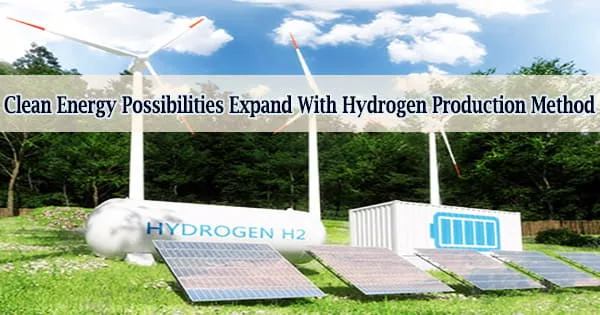Clean hydrogen fuel could become a more realistic alternative to gasoline as a result of a new energy-efficient method of producing hydrogen gas from ethanol and water. In a unique conversion mechanism, Washington State University researchers employed a mixture of ethanol and water, as well as a little amount of power, to make pure compressed hydrogen.
Because of the breakthrough, hydrogen could be produced on-site at filling stations, requiring just the transportation of the ethanol solution. It’s a significant step toward reducing the need for high-pressure hydrogen gas transportation, which has been a major roadblock to its usage as a clean energy fuel.
“This is a new way of thinking about how to produce hydrogen gas,” said Su Ha, professor in the Gene and Linda Voiland School of Chemical Engineering and Bioengineering and corresponding author on the paper published in the journal, Applied Catalysis A.
“If there are enough resources, I think it has a really good chance of making a big impact on the hydrogen economy in the near future.”
Hydrogen can be produced in low-carbon pathways using a variety of domestic resources, including fossil fuels like natural gas and coal combined with carbon capture and storage; water splitting using nuclear energy and renewable energy sources like wind, solar, geothermal, and hydropower; and biomass through biological processes.
Hydrogen as an automobile fuel is a promising but unreached sustainable energy option. A hydrogen fuel-cell vehicle, like an electric vehicle, emits no damaging carbon dioxide. It can be fueled with hydrogen gas in minutes at hydrogen fueling stations, unlike an electric automobile.
Despite the promise of hydrogen technology, storing and transporting high-pressure hydrogen gas in fuel tanks poses substantial financial and safety risks. Due to the difficulties, there is limited hydrogen gas infrastructure in the United States, and the technology has a low market penetration.
A process that offers a low-electrical energy cost alternative to water electrolysis and can effectively capture carbon dioxide while producing compressed hydrogen could have a significant impact on the hydrogen economy. It’s really exciting because there are a whole lot of aspects that play into improving the production methods of hydrogen.
Jamie Kee
The WSU researchers devised a conversion device that had an anode and a cathode. They were able to electrochemically manufacture pure compressed hydrogen by putting a modest quantity of electricity into an ethanol and water mixture using a catalyst. The reaction’s carbon dioxide is collected as a liquid.
The conversion method would allow existing infrastructure for transporting ethanol to be used instead of hazardous hydrogen gas, and compressed hydrogen gas could be readily and safely manufactured on-demand at gas stations.
“We’re already using ethanol-containing gasoline at every gas station,” said Ha. “You can imagine that an ethanol-water mixture can be easily delivered to a local gas station using our existing infrastructure, and then using our technology, you can produce hydrogen that is ready to pump into a hydrogen fuel cell car. We don’t need to worry about hydrogen storage or transportation at all.”
The electrochemical device devised by the team consumes less than half the electricity of pure water splitting, another way for producing de-carbonized hydrogen that researchers have looked into.
Rather than exerting more effort later in the process to compress the hydrogen gas, the researchers saved energy by compressing the liquid ethanol combination first, resulting in an already compressed hydrogen gas.
“The presence of the ethanol in water changes the chemistry,” said graduate student Wei-Jyun Wang, a co-lead author on the paper. “We can actually do our reaction at a much lower electrical voltage than is typically needed for pure water electrolysis.”
In addition, unlike previous water splitting systems, their approach does not necessitate the use of an expensive membrane. The electrochemical process produces hydrogen, which is then ready for consumption.
“A process that offers a low-electrical energy cost alternative to water electrolysis and can effectively capture carbon dioxide while producing compressed hydrogen could have a significant impact on the hydrogen economy,” said Jamie Kee, a Voiland School postdoctoral researcher and one of lead authors on the paper.
“It’s really exciting because there are a whole lot of aspects that play into improving the production methods of hydrogen.”
The researchers are attempting to scale up the technique so that it may be used indefinitely. They’re also trying to figure out how to utilize the carbon dioxide that’s been trapped in the liquid. The work was funded by the Gas Technology Institute and the US Department of Energy’s RAPID Manufacturing Institute.





